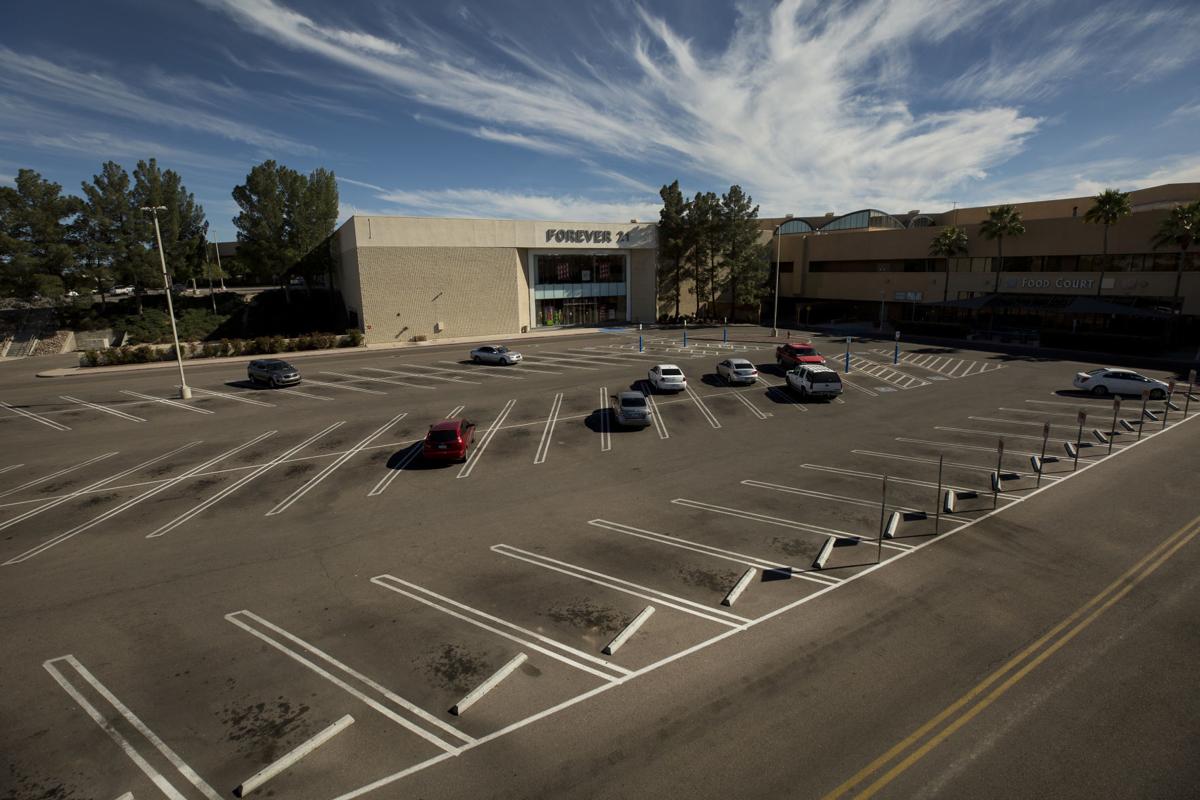PHOENIX — Arizona employers are continuing to lay off workers even with the end of coronavirus restrictions Gov. Doug Ducey had placed on individuals and businesses.
New figures from the Department of Economic Security show that 23,037 people filed for first-time jobless benefits in the past week. That’s up from fewer than 22,000 the week before.
On one hand, those numbers are a sharp decline from what happened to the Arizona economy after Ducey imposed his stay-home order and ordered the closure of all but businesses he considered essential. That led to claims for basic state unemployment benefits, which previously had been running in the 3,500-a-week range, ballooning past 132,000.
But University of Arizona economist George Hammond says the state is far from being out of the fiscal woods.
He told Capitol Media Services that some sectors of the economy, like bars and restaurants, are finding they really can’t return to prepandemic business levels because of social-distancing restrictions. At the same time, many Arizonans are not confident about the safety of going back out, at least not yet.
And that, Hammond said, will lead to new layoffs as well as some people who had only been furloughed realizing that they’re not going to be called back and deciding they need unemployment benefits.
The DES report came as the Department of Health Services logged an additional 23 deaths from COVID-19 on Tuesday, bringing the statewide tally to 1,070. Total cases increased by 618 to 28,296.
The governor has said repeatedly that the increase, at least in cases, reflects the fact the state is doing more testing. More people getting checked out, he said, means more cases will be found.
But Tuesday’s report from the DHS suggests there’s more going on. The number of hospital beds in use statewide by COVID-19 patients is 1,243. That compares with about 730 a month earlier.
Breaking down the numbers even further, there were 438 intensive-care beds occupied by those with the virus on June 8 — a record. Also setting a record were the 848 cases of the virus in hospital emergency rooms, up from 454 just a month earlier.
The new report on first-time jobless claims, directly linked to the pandemic and the governor’s subsequent orders, shows the trends are less clear.
The DES reports the number actually increased from the prior week. But the figures are complicated by questions about how the agency tracks the applications.
Since the governor put his orders in place, the agency lists nearly 650,000 Arizonans who have sought basic state benefits to those who lose work through no fault of their own. They’re entitled to half of what they were making, subject to a cap of $240 a week, the second-lowest payout in the country.
Only thing is, DES officials say there could be some duplication in those numbers.
For example, some companies are furloughing workers one week out of every month. Agency spokesman Brett Bezio said the question of how they are counted depends on whether they simply reopen existing claims every four weeks or file new ones.
Then there’s the separate Pandemic Unemployment Assistance program, which provides up to $600 a week for those who are not eligible for regular state unemployment benefits, like the self-employed and workers in the “gig” economy like drivers for Lyft and Uber who are classified by those companies as contractors.
The DES reports there were 96,416 initial claims this past week for this coverage, bringing the total number of claims to nearly 295,000. But here, too, Bezio said the agency cannot say how many of these people applied initially for regular jobless benefits — and are included in those numbers — before seeking PUA when they were determined ineligible, versus those who applied solely for PUA benefits.
But the bottom line remains that, whatever the counting methodology, Arizonans are continuing to apply for aid.
Hammond, the director of the Economic and Business Research Center at the University of Arizona’s Eller College of Management, said the numbers reflect the diversity of the state economy — and the fact that not all sectors are recovering at the same rate.
However, he expects a strong recovery in the health-care industry.
There had been some lags there when the governor declared a ban on nonessential surgeries and medical procedures in a bid to ensure there were not just enough hospital beds but also sufficient protective equipment, like gowns, masks and gloves. Ducey has since told medical providers they are free to resume elective surgeries.
And everyone else?
“In other sectors, where the fear isn’t so great, they’re going to rehire,” Hammond said. “We’re going to see the layoffs gradually drift down.”
That, in turn, goes to the part of the problem unrelated to gubernatorial directives: vonsumer confidence.
“That’s really the million-dollar — or billion-dollar question,” Hammond said. “How safe will people feel going back into restaurants, bars, hotels, motels, sporting events once those start back up?”
And there’s another side to that. “How safe do employees feel going back to work and dealing with people?” Hammond asked.
OpenTable, which helps people book reservations online, reports that dine-in seating at Arizona restaurants on Monday was down just 37.4% from the same period a year earlier. Just a week earlier, the figure was a 60% year-over-year drop.
By contrast, OpenTable reports seated dinners from online, phone and walk-in reservations in California are still almost 79% less than last year. And in New Mexico the decline is nearly 70%.
Photos for May 29: Tucson gets by during Coronavirus Pandemic
Tucson gets by during coronavirus pandemic
Updated
The iconic Casa Molina bull and matador statue both sport masks on the first full week of the loosening of COVID19 restrictions, May 23, 2020, Tucson, Ariz. The bull previously had a mask on the testicles.
Tucson gets by during coronavirus pandemic
Updated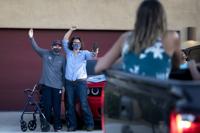
Michelle Leon Cordova, right, mother, and her son Sahuarita High School senior Lino Cordova, whom is fighting cancer, wave at staff members from Diamonds Children Center, friends and the Marana Police Department during a car parade, celebrating Lino's graduation, outside of his home on May 13, 2020 in Sahuarita, Ariz. Cordova stood on the sidewalk while the team from Diamond Children Center, friends and the Marana police department gave Cordova a graduation gar parade. Cordova was given a gift basket with his favorite snacks, gift cards as well as other items he enjoys. The car parade, also, celebrated another graduating senior fighting cancer from Empire High School, Noah Nieto. Nieto, also, received a gift basket with snacks, gift cards and other items Lino enjoys.
Tucson gets by during coronavirus pandemic
Updated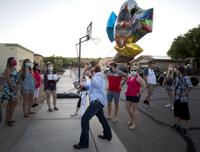
Michelle Leon Cordova, right, mother, brings celebration balloons to a car after staff members from Diamonds Children Center, friends and the Marana Police Department celebrate Sahuarita High School senior Lino Cordova, whom is fighting cancer, graduation with a car parade outside of his home on May 13, 2020 in Sahuarita, Ariz. Cordova stood on the sidewalk while the team from Diamond Children Center, friends and the Marana police department gave Cordova a graduation gar parade. Cordova was given a gift basket with his favorite snacks, gift cards as well as other items he enjoys. The car parade, also, celebrated another graduating senior fighting cancer from Empire High School, Noah Nieto. Nieto, also, received a gift basket with snacks, gift cards and other items Lino enjoys.
Tucson gets by during coronavirus pandemic
Updated
Personnel from Tucson Medical Center line the heliport to watch A-10's from Davis-Monthan Air Force Base's 355th Wing and F-16's from the Arizona Air National Guard's 162nd Wing make a pass over the facility, one leg of an area wide community flyover, May 14, 2020, Tucson, Ariz.
Tucson gets by during coronavirus pandemic
Updated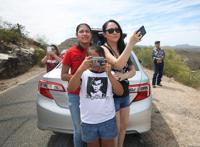
Nancy Celix-Campos, right, a respitory therapist at Tucson Medical Center, watches the military flyover with her daughters, Giana, 12, and Jazmyn, 8, from Sentinel Peak on May 14, 2020. Two F-16 Fighting Falcons from Arizona Air National GuardÕs 162nd Wing and two A-10 Thunderbolt II's from the 355th Wing, assigned to Davis-Monthan Air Force Base, fly over Tucson area hospitals to honor healthcare personnel and first responders as they are some of the frontline workers dealing with the coronavirus disease (COVID-19) head on. "It's been an exhausting two to three months," says Campos, "it's pretty cool, I like how they're going by each hospital."
Tucson gets by during coronavirus pandemic
Updated
Two F-16 Fighting Falcons from Arizona Air National Guard’s 162nd Wing and two A-10 Thunderbolt II's from the 355th Wing, assigned to Davis-Monthan Air Force Base, fly over Northwest Medical Center north of Tucson on May 14, 2020.
Tucson gets by during coronavirus pandemic
Updated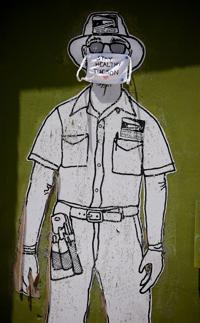
A letter carrier portrait on the Ok Market building, located in the Armory Park neighborhood, is adorned with a face mask on May 18, 2020.
Tucson gets by during coronavirus pandemic
Updated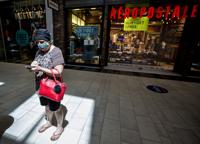
Rosemary Garcia waits for a family member outside of a store at Park Place Mall, 5870 E. Broadway Blvd., in Tucson, Ariz. on May 19, 2020. Malls reopened today under CDC guidelines and Gov. Ducey's new rules for businesses due to the Coronavirus pandemic. Park Place Mall has signs throughout the mall reminding customers to keep a six feet distance as well as hand sanitizer stations near each entrance. About half of the tables in the food court have been removed to allow for social distances as well as less than half of the stores have opened with new guidelines. Of the stores open, only 10 customers are allowed to shop in each store at a time.
Tucson gets by during coronavirus pandemic
Updated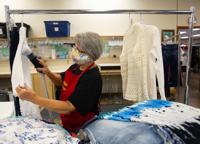
Pat Schlote steams clothing before it is put on the sales floor at the Golden Goose Thrift Shop in Catalina, Ariz., on May 21, 2020.
Tucson gets by during coronavirus pandemic
Updated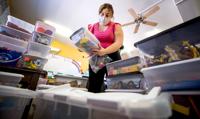
Ada Contreras, teaching assistant, looks through containers while reorganizing toys at Herencia Guadalupana Lab School, 6740 S. in Tucson, Ariz. on May 21, 2020. As Child care centers begin to re-open when they are ready, Herencia Guadalupana Lab School is reorganizing and cleaning everything in the facility before re-opening on June 2. To allow for social distancing and decrease the amount of items children touch, Herencia Guadalupana Lab School has sheds where items will go as well as placing items in containers organized by category.
Tucson gets by during coronavirus pandemic
Updated
Jen Martinez, right, softball coach, teaches Skylar Reilly about hitting during a session at Centerfield Baseball Academy, 5120 S. Julian Dr., in Tucson, Ariz. on May 21, 2020. After re-opening on Monday, Centerfield Baseball Academy has implemented new policies in response to the Coronavirus Pandemic such as wearing masks, cleaning, signage, hand sanitizer and limiting the amount of people inside the facility.
Tucson gets by during coronavirus pandemic
Updated
Karl Bosma, left, and George Cantua, with facilities and maintenance, lay down stickers to mark six-foot separation distance around one of the baggage carousels, part of the efforts at Tucson International Airport to work within the restrictions of COVID19, May 22, 2020, Tucson, Ariz.
Tucson gets by during coronavirus pandemic
Updated
A lone passenger waits for a flight near one of the shuttered restaurants in the B Gates before Memorial Day at Tucson International Airport on May 22, 2020.
Tucson gets by during coronavirus pandemic
Updated
Drew Cooper on the stage in the St. Philip's Plaza courtyard, May 22, 2020, Tucson, Ariz., where live music is back on the schedule.
Tucson gets by during coronavirus pandemic
Updated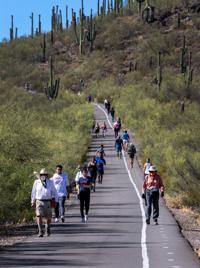
Many people visit Tumamoc Hill during the first day of Tumamoc's re-opening in Tucson, Ariz. on May 25, 2020. After being closed due to the Coronavirus pandemic, Tumamoc Hill re-opened with some modifications. There are hand sanitizer stations throughout the hike to the top as well as arrows, spaced 10-ft apart, lined up and down the hill. Some runners, hikers and walkers are also wearing masks during their hike. "The steps we are taking aim to provide our community with needed exercise, connection to our beautiful desert and a sense of comfort in such a trying time, while balancing the fact that gathering as a community endangers each of us and our loved ones. This is an unprecedented challenge that we are taking extremely seriously," said Benjamin T. Wilder, director of Tumamoc Hill. Visitors are also asked to limit their group to three people and to not touch the gate at the top of the hill- a tradition for some who make it to the top. "This is a time when we need to establish new traditions and adapt in a creative manner that embraces empathy, unity, care and patience," Wilder said.
Tucson gets by during coronavirus pandemic
Updated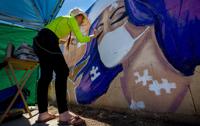
Pen Macias, artist, works on part 2 of a mural for a client on E. Broadway Rd., between S. Columbus Blvd. and S. Alvernon Way, in Tucson, Ariz. on May 25, 2020. Macias, known as The Desert Pen, has been working on her clients mural for the past three months. "It's the one thing I love, I have a passion for and the only thing I could be happy doing," said Macias. The mural represents her client, a single mother of four who works in the health care field. One half of the mural is dedicated to the connection between mothers and their children. The other half is dedicated to the connection between nurses and patients. The client wanted some positivity in the mural to show how nurses give a piece of themselves to their patients hence the puzzle pieces in the nurse and the patients, said Macias.
Tucson gets by during coronavirus pandemic
Updated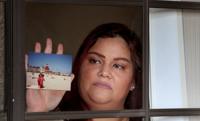
Christina Cortinas, posing at her home, May 28, 2020, Tucson, Ariz., with a photo of her and her mother, Catherine Rodriguez, in San Diego, 1991. Rodriguez is currently in assisted living and fighting COVID19. Cortinas hasn't seen her mother in months, the longest such span in her life.
Tucson gets by during coronavirus pandemic
Updated
Ruben Lopez looks through handouts while attending a Eviction Resource Fair with his family outside the Pima County Justice Court.



